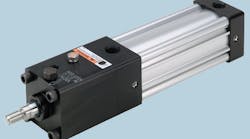A great benefit of using NFPA-standard cylinders is that you know they'll be dimensionally interchangeable from one manufacturer to another. Of course, this interchangeability does not necessarily mean that cylinder features and performance are identical among different manufacturers. Manufacturers have design flexibility as long as the cylinder conforms to NFPA standards.
The cylinders are available in any practical stroke and seven bore sizes from 1.125 to 5.0 in. and with a pressure rating of 250 psig. They also make use of composite materials that deliver the same service life as aluminum or bronze, combined with die-cast end cap design, making the average weight of the 3MA cylinder 15% less than comparable cylinders. Composite materials also reduce inertia of moving parts and exhibit lower friction than other materials. An added advantage of composite piston and end cap inserts is noise reduction of 12 dB when compared with typical aluminum cylinder designs.
For details on the 3MA Series of NFPA cylinders, contact Parker Hannifin Corp., Actuator Div., at (847) 298-2400 or visit www.parker.com/actuator


